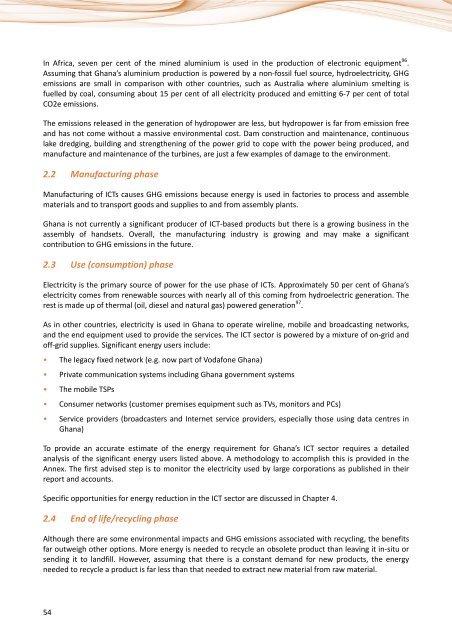Information and communication technologies (ICTs) and ... - ITU
Information and communication technologies (ICTs) and ... - ITU
Information and communication technologies (ICTs) and ... - ITU
Create successful ePaper yourself
Turn your PDF publications into a flip-book with our unique Google optimized e-Paper software.
In Africa, seven per cent of the mined aluminium is used in the production of electronic equipment 96 .<br />
Assuming that Ghana’s aluminium production is powered by a non-fossil fuel source, hydroelectricity, GHG<br />
emissions are small in comparison with other countries, such as Australia where aluminium smelting is<br />
fuelled by coal, consuming about 15 per cent of all electricity produced <strong>and</strong> emitting 6-7 per cent of total<br />
CO2e emissions.<br />
The emissions released in the generation of hydropower are less, but hydropower is far from emission free<br />
<strong>and</strong> has not come without a massive environmental cost. Dam construction <strong>and</strong> maintenance, continuous<br />
lake dredging, building <strong>and</strong> strengthening of the power grid to cope with the power being produced, <strong>and</strong><br />
manufacture <strong>and</strong> maintenance of the turbines, are just a few examples of damage to the environment.<br />
2.2 Manufacturing phase<br />
Manufacturing of <strong>ICTs</strong> causes GHG emissions because energy is used in factories to process <strong>and</strong> assemble<br />
materials <strong>and</strong> to transport goods <strong>and</strong> supplies to <strong>and</strong> from assembly plants.<br />
Ghana is not currently a significant producer of ICT-based products but there is a growing business in the<br />
assembly of h<strong>and</strong>sets. Overall, the manufacturing industry is growing <strong>and</strong> may make a significant<br />
contribution to GHG emissions in the future.<br />
2.3 Use (consumption) phase<br />
Electricity is the primary source of power for the use phase of <strong>ICTs</strong>. Approximately 50 per cent of Ghana’s<br />
electricity comes from renewable sources with nearly all of this coming from hydroelectric generation. The<br />
rest is made up of thermal (oil, diesel <strong>and</strong> natural gas) powered generation 97 .<br />
As in other countries, electricity is used in Ghana to operate wireline, mobile <strong>and</strong> broadcasting networks,<br />
<strong>and</strong> the end equipment used to provide the services. The ICT sector is powered by a mixture of on-grid <strong>and</strong><br />
off-grid supplies. Significant energy users include:<br />
• The legacy fixed network (e.g. now part of Vodafone Ghana)<br />
• Private <strong>communication</strong> systems including Ghana government systems<br />
• The mobile TSPs<br />
• Consumer networks (customer premises equipment such as TVs, monitors <strong>and</strong> PCs)<br />
• Service providers (broadcasters <strong>and</strong> Internet service providers, especially those using data centres in<br />
Ghana)<br />
To provide an accurate estimate of the energy requirement for Ghana’s ICT sector requires a detailed<br />
analysis of the significant energy users listed above. A methodology to accomplish this is provided in the<br />
Annex. The first advised step is to monitor the electricity used by large corporations as published in their<br />
report <strong>and</strong> accounts.<br />
Specific opportunities for energy reduction in the ICT sector are discussed in Chapter 4.<br />
2.4 End of life/recycling phase<br />
Although there are some environmental impacts <strong>and</strong> GHG emissions associated with recycling, the benefits<br />
far outweigh other options. More energy is needed to recycle an obsolete product than leaving it in-situ or<br />
sending it to l<strong>and</strong>fill. However, assuming that there is a constant dem<strong>and</strong> for new products, the energy<br />
needed to recycle a product is far less than that needed to extract new material from raw material.<br />
54

















